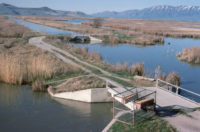New federal building and retrofit projects will be subject to updated energy consumption requirements starting in 2023, the U.S. Dept. of Energy announced. DOE estimates implementing its new rule will save the federal government $4.2 million in operating costs in the first year.
The department has also proposed new standards for residential room air conditioners and pool heaters. Together, the International Code Council estimates the new rule and proposed standards could result in more than $15 billion in savings over 30 years.
The final Baseline Energy Efficiency Standards Update for New Federal Commercial and Multi-Family High-Rise Residential Buildings, published in the Federal Register April 7, aligns the requirements for federal buildings with the 2019 ASHRAE 90.1 energy efficiency standard. A DOE analysis found the ASHRAE standard is cost-effective for new federal buildings.
The rule covers federal commercial and multifamily high-rise residential buildings. It also expands the definition of “new federal buildings” to include those leased by federal agencies and those used for privatized military housing.
The standard offers multiple routes for compliance, such as a traditional path with criteria, including minimum insulation levels and controls for lighting and heating, ventilating and air-conditioning (HVAC) systems. There are also optional compliance paths. The energy cost budget method allows a designer to offset some requirements by exceeding others. The performance rating method is for buildings that exceed the standard by following other green building certification programs, such as LEED. For designers following the performance rating method, the standard uses a new fixed baseline as part of the formula to calculate energy costs.
Regulated and Unregulated Energy Use
The standard also defines “regulated energy use” and “unregulated energy use.” Regulated uses include HVAC, lighting, elevators, refrigeration equipment, computer-room cooling equipment and other building systems. Computers, other electronic devices and non-refrigerated cooking equipment are unregulated.
Addenda published with the standard also add 29 building system changes expected to decrease energy use, such as modifying exceptions to exhaust air recovery requirements and updating parking garage lighting control requirements.
The rule will have an impact on federal building projects with design or construction beginning on or after next April 7.





